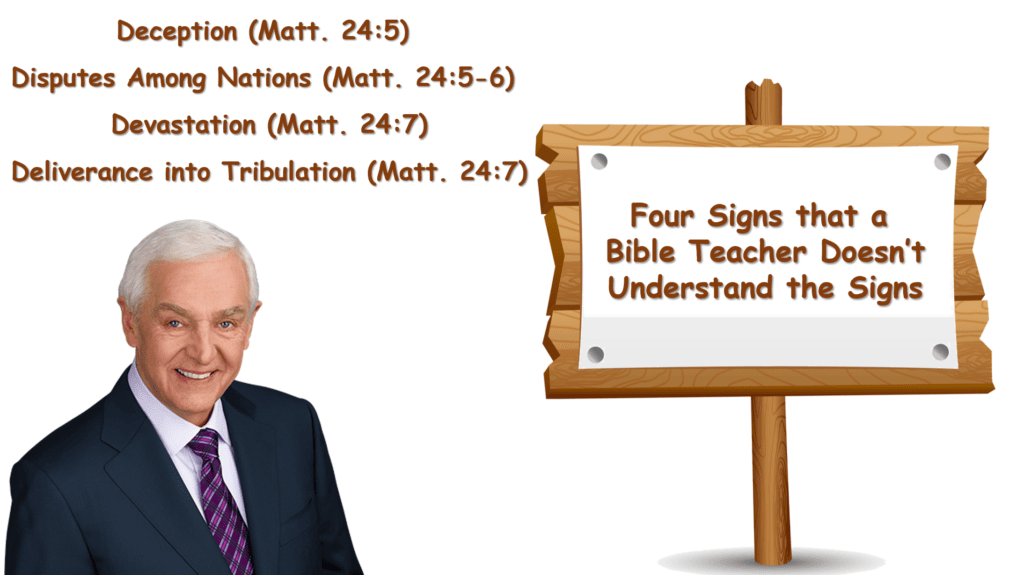Four Signs that a Bible Teacher Doesn’t Understand the Signs
Copyright © Robert E. Cruickshank, Jr (April 14, 2023)
Karen Rogers (Editor)
All Rights Reserved
Pop-prophecy pundit, David Jeremiah, claims there are “four signs of the end times” by which he can “…say with certainty that we are closer to the Rapture and the Tribulation than ever before…as the world hurtles toward earth’s Last Days.”[1] These “four signs” are: deception, disputes among nations, devastation, and deliverance into tribulation. He pulls all of these from Jesus’ Olivet Discourse in Matthew 24. Since all these “signs” were to take place before the first-century generation passed away (Matt. 24:34), Jeremiah is missing the who, when and where of the context in which these “signs” were intended.
Jeremiah claims “The Sign of Deception” may “be one of the greatest threats to the Church today, but it is nothing new.” Ironically, this writer would have to agree that “deception” has been a persistent problem but not in the way Jeremiah proposes. Nor is this “deception” a sign of the end of the world. God’s People have been continually “deceived” into believing they’re the ones living in “the last days.” In the book, The Day and the Hour, Francis X. Gumerlock spans two thousand years of conjecture over the last days and exposes the erroneous predictions that have been made, century after century, in this regard.[2] David Jeremiah is merely one of the latest contributors to this cognitive ignorance.
Next, Jeremiah cites “The Sign of Disputes Among Nations” and claims it is “shocking” that the Bible would have “predicted” things like “conflict,” “wars” and “national battles.” What is “shocking” is that anyone even remotely acquainted with the human race would find these things “shocking.” “Disputes among nations” is hardly a “sign” of anything unless, of course, the prediction was given during a time of relative peace in the world. In which case, it would have been quite significant. More on that later.
“The Sign of Devastation” is third on Jeremiah’s list. Mentioning Jesus’ reference to “famines, pestilences, and earthquakes” (Matt. 24:7), Jeremiah would have us believe that this has zero to do with “famines, pestilences, and earthquakes” in the disciples’ own day and age. Instead, he focuses on seismic activity from 1900 to the present and new outbreaks of disease reported by The World Health Organization. Supposedly, Jesus was warning his disciples about “COVID 19,” “recent outbreaks of yellow fever,” and new “superbugs” that “are developing resistance to antibiotics.”
The final portent that Jeremiah highlights is “The Sign of Deliverance Into Tribulation.” He quotes Matthew 24:9 which says, “Then they will deliver you to tribulation, and will kill you, and you will be hated by all nations on account of me.” Then he claims, “We are already seeing evidence of this today.” If we’re only now seeing evidence of this, it’s 2000 years too late. Jesus wasn’t telling us, twenty-first century Americans, that we would see this Tribulation. He was talking about a Tribulation that His first-century followers would experience.
We may or may not see tribulation in our own time, but it would have nothing to do with THE Tribulation Jesus was talking about 2000 years ago. Additionally, the examples Jeremiah cites of supposed current tribulation, such as “school boards” routinely “passing over Christian faculty members for promotions,” are a far-cry from the type of real tribulation Jesus’ original followers faced.
When Jesus said they will deliver “you” to tribulation, He was using the second-personal plural. In fact, He uses the second-person plural, “you,” repeatedly throughout the Olivet Discourse. He is speaking to His first-century disciples and telling them that they would witness the deception, the disputes among nations, and the devastation. If He meant that some other generation would experience these things, He would have used the third-personal plural, “they,” just as we do now when referring to them (i.e., His first-century followers). This is also how we today would refer to a future generation, 2000 years from now. Did the Creator of the languages of the earth (Gen. 10:7-8) not know how to use language properly?
The reality is that they did indeed experience the tribulation of which Jesus spoke. In fact, the Apostle John tells the first-century believers of Asia Minor that he was their “fellow partaker in the tribulation” (Rev. 1:9). John is not referring to tribulation in general but to THE Tribulation. The definite article is there in the Greek. As David Chilton comments, “St. John is thinking about a special period of hardship; not just tribulation in general, but the tribulation, the subject of much apostolic writing as the age of the Last Days progressed to its climax (1 Thess. 1:6; 3:4; 2 Thess. 1:4-10; 1 Tim. 4:1-3; 2 Tim. 3:1-12).”[3]
Those same first-century believers also experienced the signs of devastation spoken of in Matthew 24:7. While the prophecy gurus of our day claim “nothing” in history shows that these events happened in the first century,[4] the Bible itself records it for us. As Gary DeMar writes, “Nothing? Jesus predicted that there would be earthquakes before that first-century generation passed away. There were earthquakes (Matt. 27:54; 28:2; Acts 16:26) and famines (Acts 11:28; cf. Rom. 8:35), just like Jesus predicted (Matt. 24:7).”[5]
Famine and pestilence only increased as AD 70 drew closer. F.W. Farrar writes, “The incidents of the famine which then fell on the besieged are among the most horrible in human literature. The corpses bred a pestilence. Whole houses were filled with unburied families of the dead. Mothers slew and devoured their own children. Hunger, rage, despair, and madness seized the city. It became a cage of furious madmen, a city of howling wild beasts, and of cannibals—a hell!”[6]
“The Sign of Disputes Among Nations” would have been especially pertinent in the first century when Jesus’ words were spoken. In order for something to truly be a “sign,” it would have to be out of the ordinary. Nations rising against one another (Matt. 24:7) is hardly out of the ordinary for almost any period in human history. The operative word here is “almost.” When Jesus uttered these words to His first-century disciples, they were currently living in a time period known as the Pax Romana (Roman Peace) that began with the reign of Augustus and his establishment of the “Age of Peace” in 17 B.C.[7] Beginning in the mid to lates 60s, the Roman-Jewish War was a significant interruption to this, and Jerusalem was destroyed in 70. “Wars and rumors of war” (Matt. 24:6) can only be a “sign” during a period of relative peace.
Finally, it scarcely requires proof to show that “The Sign of Deception” was on full display in the first century. Deception was a clear and present danger among the original generation of Jesus’ followers, and entire epistles were written to counteract the threat. Paul’s letter to the Galatians deals with the Judaizers who were bent on deceiving Gentile believers into thinking the rite of circumcision was still required. The book of Hebrews was written to warn Jewish believers not to be deceived into returning to the types and shadows of the Old Covenant. In 1 John, the deceptive Antichrists were evidence that it was the “last hour” then—in the first century. Jude is written to warn the first-century believers of deceivers in their own day who had crept in unnoticed (Jude 2). Deception was rampant in the first century, and much of the New Testament was written in direct response to it.
Scripture itself is our guide for understanding these four signs, not the latest news headlines. All four of the signs that Jeremiah mentions are signs given to Jesus’ first-century disciples and deal with events leading up to and including the destruction of Jerusalem in AD 70. This is the who, when, and where of the context. The four signs that Jeremiah doesn’t understand “the signs” is the fact that he thinks all four signs are all about us, today, in the modern world.
[1] https://davidjeremiah.blog/4-signs-of-the-end-times/
[2] https://store.americanvision.org/products/the-day-and-the-hour-christianitys-perennial-fascination-with-predicting-the-end-of-the-world?_pos=1&_sid=92cdc89bf&_ss=r
[3] David Chilton, The Days of Vengeance: An Exposition of the Book of Revelation (Tyler, TX: Dominion Press, 1987), p. 68 https://store.americanvision.org/products/the-days-of-vengeance?_pos=1&_sid=377c05871&_ss=r
https://www.garynorth.com/freebooks/docs/pdf/days_of_vengeance.pdf
[4] Robert Van Kampen, The Sign of Christ’s Coming and the End of the Age (Wheaton, IL: Crossway Books, 1999), p. 14.
[5] Gary DeMar, Last Days Madness: Obsession of the Modern Church (Powder Springs, GA: American Vision, 2019), p. ix.. https://store.americanvision.org/products/last-days-madness?_pos=1&_sid=cc84dc803&_ss=r
[6] Q: John L. Bray, Matthew 24 Fulfilled (Powder Springs, GA: American Vision Press, 2008), p. 88. https://store.americanvision.org/products/matthew-24-fulfilled?_pos=1&_sid=d3a08ac77&_ss=r
[7] DeMar, Last Days, p. 78.

